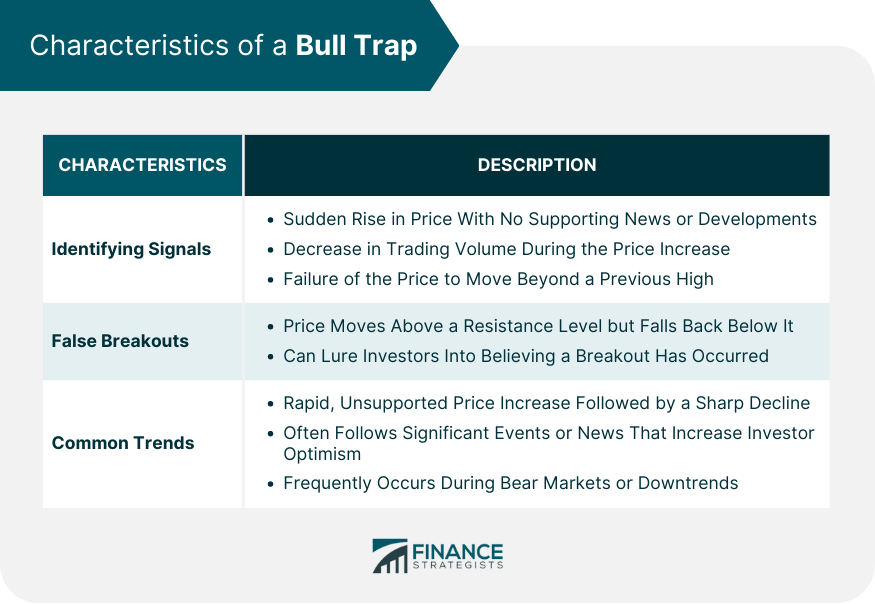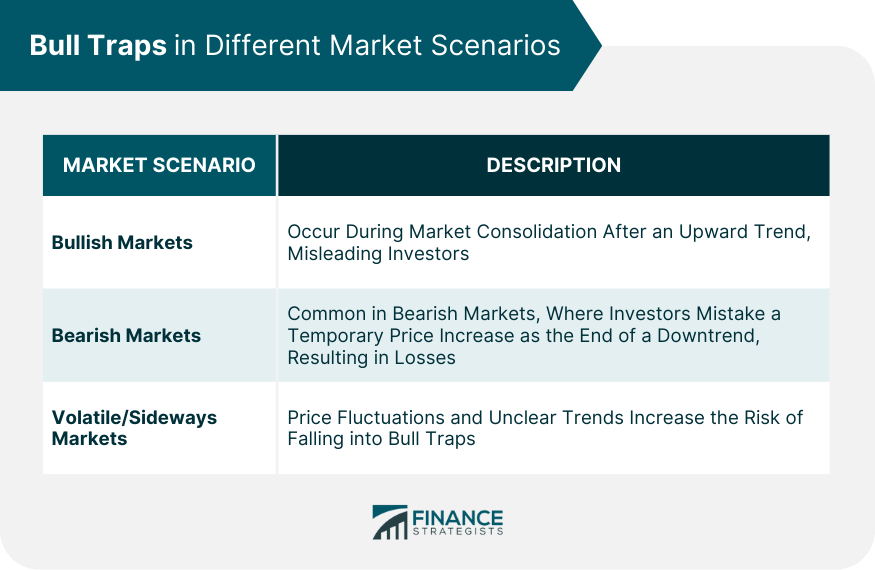A Bull Trap is a false market signal indicating a reversal from a downtrend to an uptrend in a financial asset's price. This deceptive signal leads investors to buy, anticipating a market rise. However, the asset's price declines soon after, trapping the bullish traders who bought in anticipation of growth that never materializes. Originating from the deceptive calm of a trapped bull before it lashes out, the term "Bull Trap" illustrates the potential significant losses resulting from these false signals. Bull traps are particularly problematic for traders and investors heavily relying on technical analysis. With today's fast-paced, interconnected financial markets, the prevalence and impact of bull traps have increased due to rapid swings in investor sentiment. Identifying a bull trap can be tricky, especially for novice investors. Several signals, though, can indicate the presence of a bull trap. These include a sudden rise in price with no supporting news or developments, a decrease in trading volume during the price increase, and a failure of the price to move beyond a previous high. A significant characteristic of bull traps is the phenomenon of false breakouts. These occur when the price of an asset moves above a resistance level (the price level which the asset has difficulty moving beyond) but then falls back below it. This movement can lure investors into believing a breakout has occurred and an uptrend has started, leading to the trap. Common trends in bull traps include a rapid, unsupported price increase, followed by a sharp decline. The pattern often follows significant events or news that might lead to increased optimism among investors. Additionally, bull traps frequently occur during bear markets or downtrends when investors are looking for signs of reversal. Market psychology plays a central role in the formation of bull traps. Investors, driven by fear of missing out (FOMO), may jump onto the perceived upward trend without adequately evaluating the market conditions. This rush to buy can accelerate the price increase, further fueling the perception of a bull market. But when this optimism is unsupported by fundamentals, the correction can be swift and severe, resulting in a bull trap. Trading volume, or the number of shares or contracts traded in a security or market during a given period, can significantly impact the formation of bull traps. Low trading volume during a price increase can signal a lack of broad market support for the uptrend, possibly indicating a bull trap. Conversely, a high volume of trading can suggest strong support, reducing the likelihood of a bull trap. Technical analysis, which involves evaluating securities by analyzing statistics generated by market activity, such as past prices and volume, can play a critical role in predicting bull traps. Indicators like moving averages, relative strength index (RSI), and Bollinger Bands, among others, can help identify market conditions that often precede bull traps. The principal risk of a bull trap is the potential financial loss. Investors, deceived into believing that the market trend is bullish, often invest heavily. However, when the supposed upward trend quickly reverses, they are left with depreciated assets. Selling these assets to cut losses culminates in a losing trade, a direct financial blow to the investor. Beyond the immediate financial implications, recurring instances of falling into bull traps can inflict significant emotional distress on investors. The experience can undermine their confidence in making future investment decisions, potentially leading to missed opportunities or overcautious investing, which can also impact returns. To avoid bull traps, investors can adopt several defensive strategies. These include remaining patient and not giving in to FOMO, using stop-loss orders, performing fundamental analysis to ensure the asset's price is supported by underlying business performance, and monitoring trading volume for indications of market support. Stop-loss orders are a crucial tool for protecting investors from severe losses when caught in a bull trap. A stop-loss order is an order placed with a broker to buy or sell a security when it reaches a certain price. In the context of a bull trap, an investor would place a stop-loss order to sell the security if its price drops to a certain level. This strategy can limit the investor's loss if the price does not recover, thereby providing a safety net against the risks posed by bull traps. Even in bullish markets, bull traps can occur. These typically happen during periods of market consolidation after a substantial upward trend. Some investors might interpret this consolidation as a continuation pattern, causing them to buy in anticipation of further gains. However, if this perceived pattern is a bull trap, these investors can be caught off guard when the price falls. Bull traps are especially prevalent in bearish markets. Desperate for a turnaround, investors may misinterpret a temporary price increase as the end of a bearish trend, leading them to buy prematurely. When the price resumes its downtrend, the bull trap is sprung, leaving these hopeful investors with losses. In volatile or sideways markets, price fluctuations can frequently lead to bull traps. Unclear trends and fluctuating prices can make it difficult for investors to determine the market's direction, making them susceptible to misinterpreting signals and falling into bull traps. A crucial difference between bull traps and bear traps lies in the false market signals they send and their resulting impact. Bull traps create an illusion of a downtrend reversing into an uptrend, causing investors to buy. However, prices fall instead, leading to unexpected losses. Conversely, bear traps trick investors into believing an uptrend has reversed, inducing selling. Yet, the market surprises with a price rise, which could result in missed profit opportunities or losses from having sold too soon. Despite their differences, bull traps and bear traps share significant similarities. Both types of traps exploit investor psychology, primarily leveraging fear and greed to provoke hasty investment decisions. Investors, driven by greed, may rush to buy in a perceived uptrend (bull trap) or, governed by fear, may hasten to sell in an anticipated downtrend (bear trap). However, when the market moves contrary to expectations, significant financial losses can ensue. In essence, both bull traps and bear traps expose investors to substantial financial risks. Therefore, protective measures like stop-loss orders and careful fundamental analysis should be in place to mitigate these risks. Understanding both bull and bear traps can significantly improve trading strategies. Recognizing the signs of these traps can help investors avoid costly mistakes, while also providing opportunities for strategic trades for those who can accurately predict these traps. Bull traps in the financial market are deceptive signals that lead to significant losses as the asset's price declines after an initial rise. They are characterized by sudden price increases without supporting news, decreased trading volume, and failure to surpass previous highs. Investors should be cautious of the risks and consequences, using strategies like stop-loss orders and fundamental analysis to avoid falling into traps. Bull traps can occur in bullish, bearish, and volatile markets, misleading investors in consolidation phases or temporary price increases. Bull traps differ from bear traps as they trick investors into buying before price falls, while bear traps induce selling before prices rise. Both exploit investor psychology and carry financial risks, emphasizing the need for protective measures and recognizing the signs of traps. Investors should consider seeking wealth management services for professional guidance in navigating the complex market dynamics.What Is a Bull Trap?
Characteristics of a Bull Trap
Identifying a Bull Trap: Key Signals and Indicators
False Breakouts and Their Relation to Bull Traps
Common Trends and Patterns in Bull Traps

Understanding the Mechanisms Behind Bull Traps
Role of Market Psychology in Creating Bull Traps
Impact of Trading Volume in the Formation of Bull Traps
Role of Technical Analysis in Predicting Bull Traps
Bull Traps and Investment Strategies
Risks and Potential Consequences of Bull Traps for Investors
Threat of Financial Loss
Emotional Distress and Impact on Future Investments
Defensive Strategies to Avoid Bull Traps
Utilizing Stop-Loss Orders to Protect From Bull Traps
Bull Traps in Different Market Scenarios
Bull Traps in Bullish Markets
Bull Traps in Bearish Markets
Bull Traps in Volatile or Sideways Markets

Comparisons: Bull Traps vs Bear Traps
Key Differences
False Signals and Market Impact
Similarities Between Bull Traps and Bear Traps
Psychological Element and Potential for Financial Loss
How Understanding Both Can Improve Trading Strategies
Final Thoughts
Bull Traps FAQs
A bull trap is a false signal suggesting that a declining trend in a stock or index has reversed and is heading upwards when, in fact, the security will continue to decline.
Avoiding bull traps often involves careful technical analysis, watching for false breakouts, monitoring trading volumes, and not succumbing to the fear of missing out (FOMO).
Bull traps occur when investors wrongly believe that a stock's price is rising and buy it, only for the price to decline. Bear traps are the opposite, occurring when investors think a stock's price is falling and sell it, only for the price to rise.
Yes, AI, machine learning, and predictive analytics can analyze large amounts of historical and current data to recognize patterns and forecast the likelihood of a bull trap occurring.
Falling into a bull trap can lead to significant financial losses as investors buy a stock thinking it's on an upward trend when, in reality, its price continues to fall.
True Tamplin is a published author, public speaker, CEO of UpDigital, and founder of Finance Strategists.
True is a Certified Educator in Personal Finance (CEPF®), author of The Handy Financial Ratios Guide, a member of the Society for Advancing Business Editing and Writing, contributes to his financial education site, Finance Strategists, and has spoken to various financial communities such as the CFA Institute, as well as university students like his Alma mater, Biola University, where he received a bachelor of science in business and data analytics.
To learn more about True, visit his personal website or view his author profiles on Amazon, Nasdaq and Forbes.











